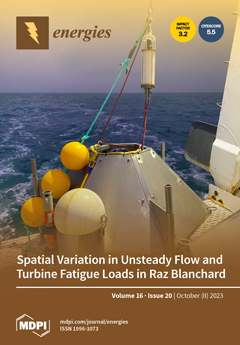CO
2-based enhanced geothermal systems (CO
2-EGS) are greatly attractive in geothermal energy production due to their high flow rates and the additional benefit of CO
2 geological storage. In this work, a CO
2-EGS model is built based on
[...] Read more.
CO
2-based enhanced geothermal systems (CO
2-EGS) are greatly attractive in geothermal energy production due to their high flow rates and the additional benefit of CO
2 geological storage. In this work, a CO
2-EGS model is built based on the available geological data in the Gonghe Basin, Northwest China. In our model, the wellbore flow is considered and coupled with a geothermal reservoir to better simulate the complex CO
2 flow and heat production behavior. Based on the fractured geothermal reservoir at depths between 2900 m and 3300 m, the long-term (30-year) heat production performance is predicted using CO
2 as the working fluid with fixed wellhead pressure. The results indicate that the proposed CO
2-EGS will obtain an ascending heat extraction rate in the first 9 years, followed by a slight decrease in the following 21 years. Due to the significant natural convection of CO
2 (e.g., low viscosity and density) in the geothermal reservoir, the mass production rate of the CO
2-EGS will reach 150 kg/s. The heat extraction rates will be greater than 32 MW throughout the 30-year production period, showing a significant production performance. However, the Joule–Thomson effect in the wellbore will result in a drastic decrease in production temperature (e.g., a 62.6 °C decrease in the production well). This means that the pre-optimization analyses and physical material treatments are required during geothermal production using CO
2 as the working fluid.
Full article





